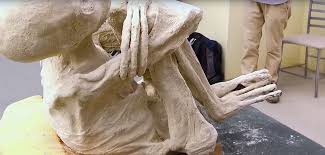
Experts from a variety of scientific fields are carrying out tests on some unusual mummies unearthed from a tomb near Nazca, Peru.
Nazca, a deeply mysterious archeological site, is well known for it’s many ancient geoglyphs of plants and animals, some of which are up to thousands of feet in size. The remarkable images are etched across several hundred kilometers of desert sand and only visible from the air or surrounding hills.

One of the huge geoglyphs at Nazca, as viewed from the air.
The mummified bodies, discovered in an ancient tomb complex in the Nazca region, are believed to have been embalmed in a herbal concoction similar to Egyptian practices. They appear coated in a chalk white powder and have a clear anatomical structure similar to humans. Yet, stunningly, the humanoid-like figures have only three extra-long digits on each of their hands and three long toes on each foot. Instead of the usual three phalanges present in a human finger, each of their digits contain 5-6 thick phalanges. In the case of the tallest mummy specimen (168 centimeters tall), a female nicknamed ‘Maria’ by the investigating team, her hands are almost twice the length of a typical human hand.
Other atypical features include having a more elongated skull that appears to have no suture lines, and no ears – just small holes where ears would normally be. Visible remnants of the skin appear grey in colour (typical of decomposition) and slightly lizard-like in texture. Samples of the mummified body sent to five laboratories around the world for testing also showed evidence of arteries, tendons, and even inner organs.
Carbon-dated at between 245-410AD, the Mummy was not found alone. Other smaller mummies with similar anatomical features were also located at the same and nearby tombs, strongly indicating the three-fingered and toed phenomena to be in no way a deformity. However, these smaller mummies were approximately only 60-100 centimeters tall, and a sample of one of these was carbon-dated at a period hundreds of years later than Maria. The smaller mummies are being considered as a similar yet different species.
Whilst there’s no historical mention of a human three-fingered and toed species on Earth, many ancient petroglyphs in South America depict images of a three-fingered humanoid-looking species – previously considered mythical, but something that perhaps could now be based more on a reality.
What’s more, the discovery tempts many questions: where did this unusual and humanoid-like species come from? Who were they? Did they once occupy other parts of South America, or even elsewhere on Earth? And were they or their distant relatives possibly the true creators of the mysterious Nazca Lines?
Such an historic and stunning discovery is likely to change many concepts and ideas in science and biology, and indeed, about our human history. Humanity may be forced to accept our lack of understanding about our ancient past; old assumptions may be challenged; we may be required to accept we really don’t know the truth: that our concepts and anthropological understandings are really just that – concepts. And as further DNA tests and discoveries are unearthed, we may in fact find ourselves at the crossroads of a brand new understanding that irrevocably alters the consciousness of humanity as a whole.
***
Louise Beker is a Life Coach and Author of several novels, ‘The Bright New Dawn‘ and ‘Her Eight Limbs of Love‘
louisebeker.com
References:
Gaia.com – ‘Unearthing Nazca’ series, 2017

Great delivery. Great arguments. Keep up the amazing effort. Ame Jordan Dona
I truly appreciate this post. I have been looking everywhere for this! Thank goodness I found it on Bing. You have made my day! Thx again! Isabel Jeth Hodosh